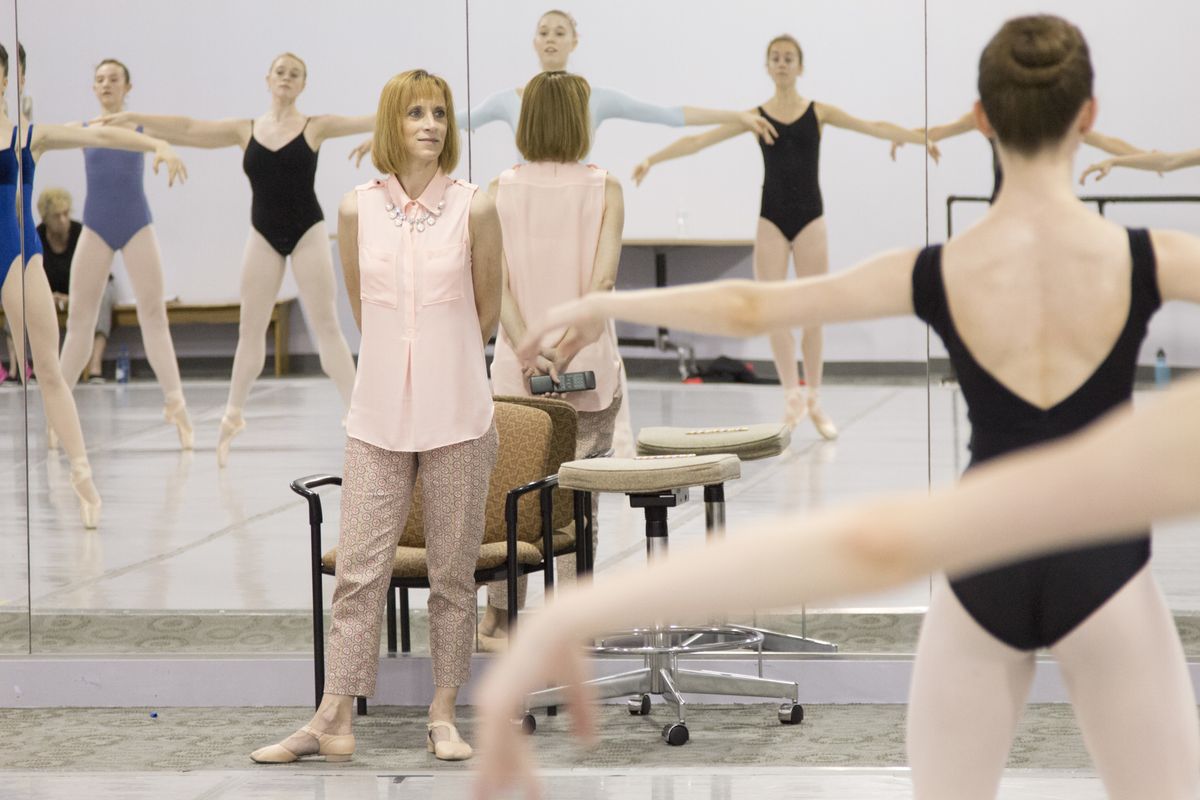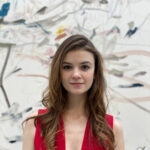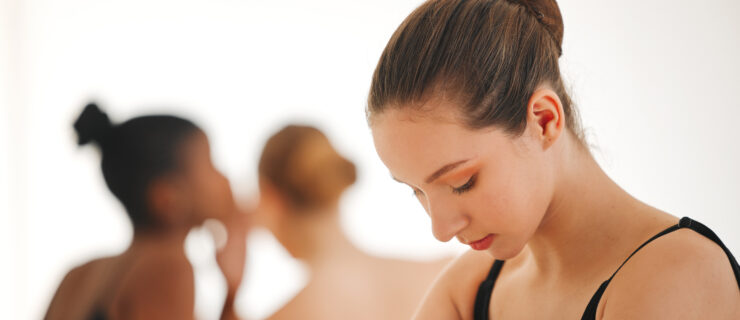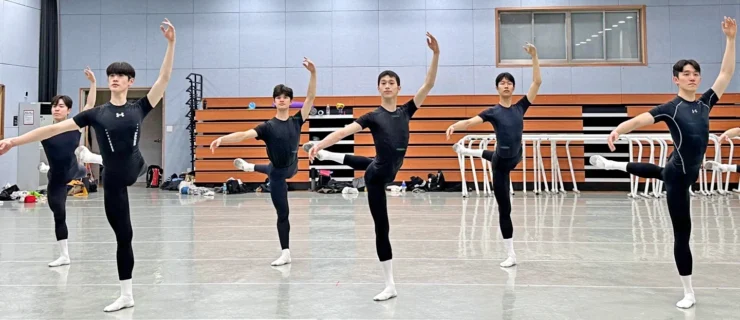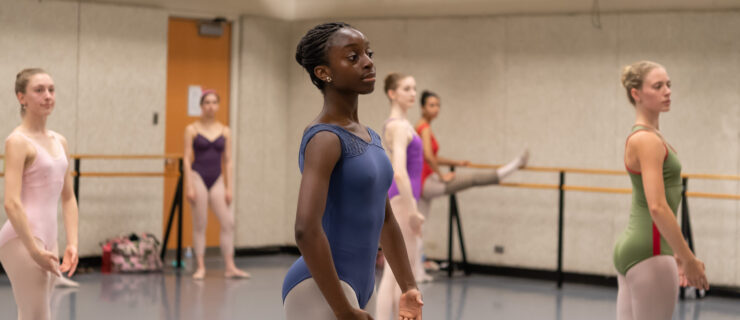The Mirror: Friend or Foe?
This story originally appeared in the April/May 2016 issue of Pointe.
Suddenly, all I could see in the mirror was a fuzzy, dancer-shaped outline. I had accidentally rubbed out my contacts right before pliés and, frustrated, resigned myself to an unproductive two hours. As class progressed, however, something strange happened: I felt far more relaxed and placed. My balances at barre were steadier, I didn’t have a single wobble in center adagio, I nailed every pirouette and even my jumps felt freer. Could the reason for this stellar class be that I wasn’t depending on my reflection?
So much of dancers’ training is through sight, usually with the mirror as an aid. From toddlers to top-ranked company members, nearly every hour of studio time is spent in front of the mirror, honing technique in class and perfecting choreography in rehearsal. Too often, however, the mirror becomes a crutch, and the very reasons you need it for your training can become detrimental. Luckily, awareness and refocusing can help break the habit.
A Helpful Point of View
There are plenty of reasons why the mirror is ever present in ballet studios. “It’s a tool to get symmetry, to get perfect lines, to see the positions that you’re supposed to make every time,” says Central Pennsylvania Youth Ballet school principal Alecia Good-Boresow. Each glance at your reflection is an opportunity to improve your technique. LeeWei Chao, a teacher at the Alonzo King LINES Ballet Training Program, sees the mirror as “a third person,” an intermediary between the dancer and instructor. When your teacher corrects you, he says, you can use this third view to help apply it.
In rehearsals, the mirror is a necessary aid in setting ballets—especially, says Good-Boresow, in corps de ballet work: “With the mirror you can make straight lines, make sure that the shapes you’re trying to create in choreography are visible to the dancers.”
 PNB’s Margaret Mullin in company class. Photo by Angela Sterling, Courtesy PNB.
PNB’s Margaret Mullin in company class. Photo by Angela Sterling, Courtesy PNB.
From Habit to Hindrance
Constantly staring at the mirror, however, causes as many problems as it solves. Good-Boresow calls dancers’ tendency to rely on their reflections “mirroritis.” While scrutinizing your image can help you self-correct and improve some aspects of your technique, it can be detrimental to your port de bras and épaulement. When your head and eyes are always focused on your reflection—likely favoring the legs and feet, Chao says—you aren’t reaching the full extent of your positions. Your head placement won’t match the reach of your lines, and arms become an afterthought rather than coordinated with the movement.
This lack of coordination is more than cosmetic. “If you use your eyes to find balance,” Chao says, “you’re not using your mind–body connection,” and you’ll lose stability when static poses become movement. To demonstrate his point in class, Chao will ask his dancers to do an arabesque. Many automatically look in the mirror to find their placement. Next, he’ll have them try an arabesque turn. The line they created with the help of the mirror isn’t there, and the turn is often unsuccessful.
The problems multiply when transitioning from studio to stage, where the mirror is replaced with the theater’s “black hole,” says Good-Boresow. Well-rehearsed spacing and traffic patterns devolve into minor mishaps at best—chaos at worst. Pacific Northwest Ballet soloist Margaret Mullin often witnesses this when PNB Professional Division students are thrown into corps spots, as they’re unaccustomed to using their peripheral vision. “When dancers have been relying on the mirror,” Mullin says, “people can panic onstage.”
In addition, when your movement is entirely based off your reflection, it’s not coming from within—or projecting out. “You’re robotic,” says Good-Boresow. “You’re not actually dancing.” Waiting until you’re onstage to make the adjustment is too little, too late.

American Ballet Theatre corps member Gisele Bethea checks her form during grand battements at the 2014 USA IBC. Photo by Jim Lafferty.
Refocus
So, how do you prevent your relationship with your reflection from becoming a dependent one? The most obvious way to gain stability and confidence sans mirror is to practice sans mirror. Both Chao and Good-Boresow will remove the temptation by closing a curtain or by asking the dancers to face the back of the room.
If the teacher doesn’t provide this impetus, however, you have to break the habit on your own. When you must use the mirror to check your placement, Mullin says, don’t just look for correctness and move on. Instead, pause and internalize what “correct” means on a deeper physical level, maybe even briefly closing your eyes. Sense where your limbs are in space, which muscles are engaged and which have feelings of length or opposition. This trains your muscle memory, allowing you to more easily reproduce the position without the mirror.
Chao recommends taking some cues from modern-dance training, which focuses less on how high the leg is or how arched the feet are. In modern, he says, “you learn how to move.” Try bringing this mentality to daily technique class. Instead of obsessing over those last few degrees of turnout, focus on transitions, movement quality and artistry.
Finally, remember that the audience won’t scrutinize your technique nearly as closely as you do. The whole point of using the mirror to improve your technique is to eventually take it away. In the end, it matters less how you look. It matters how you dance.
Up Close and Too Personal?
When you dance in front of the mirror for hours each day, it’s easy for flaws to become the whole picture. This daily self-criticism, Pacific Northwest Ballet soloist Margaret Mullin says, may lead to insecurities, which can manifest in body issues and anxiety. Here are Mullin’s tips for developing a healthy relationship with your reflection:
- Avoid instant gratification. Mullin has seen young dancers go to extremes—disordered eating, dangerous stretching techniques, et cetera—to try to achieve a certain ideal. Trust that the work will mold your body eventually; forcing it will negatively affect your health.
- Limit social media exposure. Instagram and Facebook profiles are curated to look picture-perfect. When you’re walking around with that ideal in your pocket day in and day out, insecurities are likely to follow you into the studio. Save some “likes” for yourself.
- Expect change. “I looked incredibly different at 13 than I did at 14, then 15, then 19,” Mullin says. She’s even seen professionals’ bodies change based on their current repertoire. Getting used to the idea of physical changes may help you accept them.
- Focus on fuel. “Don’t let the demons in the mirror affect how you’re nourishing yourself,” Mullin urges. Yes, dance is an aesthetic art form, but it’s also intensely physical. Talent doesn’t reside in cookie-cutter bodies, and being thin is far less important than having the energy and strength to do what’s required of you.
